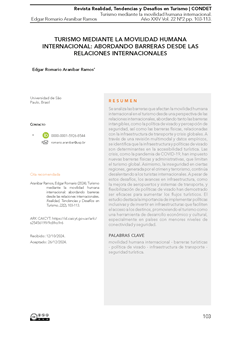Turismo mediante la movilidad humana internacional Abordando barreras desde las relaciones internacionales
Contenido principal del artículo
Resumen
Se analiza las barreras que afectan la movilidad humana internacional en el turismo desde una perspectiva de las relaciones internacionales, abordando tanto las barreras intangibles, como la política de visado y percepción de seguridad, así como las barreras físicas, relacionadas con la infraestructura de transporte y crisis globales. A través de una revisión multimodal y datos empíricos, se identifica que la infraestructura y políticas de visado son determinantes en la accesibilidad turística. Las crisis, como la pandemia de COVID-19, han impuesto nuevas barreras físicas y administrativas, que limitan el turismo global. Asimismo, la inseguridad en ciertas regiones, generada por el crimen y terrorismo, continúa desalentando a los turistas internacionales. A pesar de estos desafíos, los avances en infraestructura, como la mejora de aeropuertos y sistemas de transporte, y flexibilización de políticas de visado han demostrado ser eficaces para aumentar los flujos turísticos. El estudio destaca la importancia de implementar políticas inclusivas y de invertir en infraestructuras que faciliten el acceso a los destinos, promoviendo el turismo como una herramienta de desarrollo económico y cultural, especialmente en países con menores niveles de conectividad y seguridad.
Descargas
Detalles del artículo

Esta obra está bajo una licencia internacional Creative Commons Atribución-NoComercial-CompartirIgual 4.0.
Citas
Artal, A., Pallardó, V. y Requena, F. (2016). Examining the impact of visa restrictions on international tourist flows using panel data. Estudios de Economía, 43(2), 265-279. https://www.redalyc.org/articulo.oa?id=22149200005
Athar, M., Liu, Z., Xu, Y., Nawaz, K., Malik, M. y Younis, A. (2020). Impacts of terrorism, governance structure, military expenditures and infrastructures upon tourism: Empirical evidence from an emerging economy. Eurasian Business Review, 10, 185-206. https://doi.org/10.1007/s40821-020-00152-y
Chi, P., Lee, K. y Chang, K. (2022). Causal effect of tourist visa exemption schemes on international tourist arrivals. Economic Analysis and Policy, 75, 427-449. https://doi.org/10.1016/j.eap.2022.06.003
Chinai, R. y Goswami, R. (2007). Medical visas mark growth of Indian medical tourism. Bulletin of the World Health Organization, 85, 164-165. https://iris.who.int/bitstream/handle/10665/269842/PMC2636228.pdf
Eja, E. (2023). Exploring spatial pattern of crime dynamics and vulnerability within tourism infrastructure in Calabar, Nigeria. Spatial information research, 31(4), 381-388. https://doi.org/10.1007/s41324-022-00503-z
Feng, Y., Pitafi, A. y Zhang, C. (2023). Support for tourism development in Pakistan: A study of road and transportation infrastructure development. Heliyon, 9(7). https://doi.org/10.1016/j.heliyon.2023.e18014
Freier, L. y Holloway, K. (2019). The impact of tourist visas on intercontinental South-South migration: Ecuador’s policy of “open doors” as a quasi-experiment. International Migration Review, 53(4), 1171-1208. https://doi.org/10.1177/0197918318801068
Jones, J., Manoharan, A. y Madera, J. (2024). Lookism in hospitality and tourism workplaces: A multilevel review and research agenda. International Journal of Hospitality Management, 123, 103909. https://doi.org/10.1016/j.ijhm.2024.103909
Karaman, A. (2016). The pernicious impact of visa restrictions on inbound tourism: The case of Turkey. Turkish Studies, 17(3), 502-524. https://doi.org/10.1080/14683849.2016.1170602
Karimov, M., Jeong, J., Sobirov, Y. y Choi, C. (2023). The role of transportation infrastructure in the development of international tourism in Uzbekistan. Journal of Tourism & Development, (41). Https://doi.org/10.34624/rtd.v41i0.30576
Kim, T., Bae, E. y Kim, D. (2023). Regional visa-waiver program for open tourism development. European Planning Studies, 31(5), 974-987.https://doi.org/10.1080/09654313.2022.2132786
Lahura, E. y Sabrera, R. (2023). The effect of infrastructure investment on tourism demand: a synthetic control approach for the case of Kuelap, Peru. Empirical Economics, 65(1), 443-478. https://doi.org/10.1007/s00181-022-02334-1
Lawson, R. y Roychoudhury, S. (2016). Do travel visa requirements impede tourist travel?. Journal of Economics and Finance, 40, 817-828. https://doi.org/10.1007/s12197-015-9343-5
Lee, C., Song, H. y Bendle, L. (2010). The impact of visa-free entry on outbound tourism: a case study of South Korean travellers visiting Japan. Tourism Geographies, 12(2), 302-323. https://doi.org/10.1080/14616681003727991
Momani, A., Alsakhnini, M., Hanaysha, J. (2022). Emerging technologies and their impact on the future of the tourism and hospitality industry. International Journal of Information Systems in the Service Sector (IJISSS), 14(1), 1-18. https://doi.org/10.4018/IJISSS.287579
Sheller, M. y Urry, J. (2006). The new mobilities paradigm. Environment and planning A, 38(2), 207-226. https://doi.org/10.1080/23800127.2016.1151216
Song, H., Lee, C., Reisinger, Y. y Xu, H. (2017). The role of visa exemption in Chinese tourists’ decision-making: A model of goal-directed behavior. Journal of Travel & Tourism Marketing, 34(5), 666-679. https://doi.org/10.1080/10548408.2016.1223777
Valdés, C. (2023). Relevance and creativity and the translation of multimedia tourist material. Cultura, Lenguaje y Representación, 31, 189-214. https//doi.org/10.6035/clr.6768
Xiong, Y. y Tang, X. (2023). Tourism during health disasters: Exploring the role of health system quality, transport infrastructure, and environmental expenditures in the revival of the global tourism industry. PloS one, 18(9), e0290252. https://doi.org/10.1371/journal.pone.0290252
